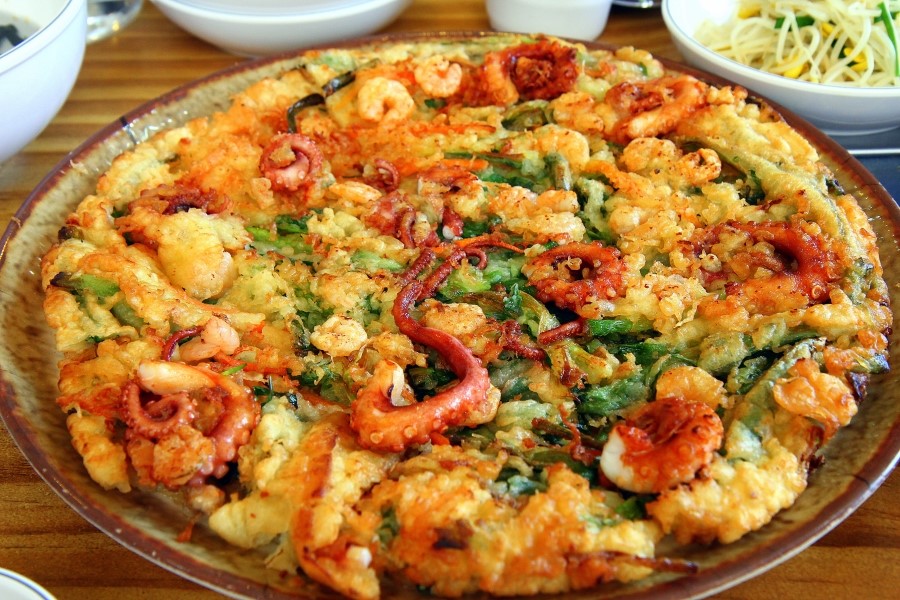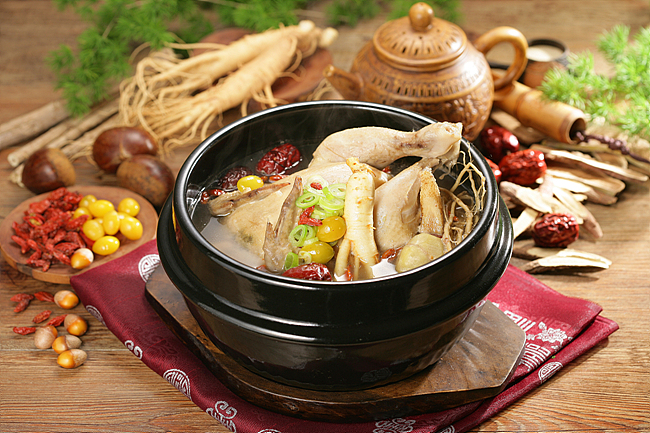On your 1st trip to South Korea and you don’t know which food could wet your appetite? Or which foods look delicious and is delicious? Here is a list of 10 foods in my opinion that you can’t miss out on your 1st trip to South Korea. Expect some soups, meat, noodles, ramyeon, snacks and so on. Though each and every food mentioned here might not suit your taste buds, at least give it a try so you can say you did it. And not live with regret about what you could have done.
-
Haemul Pajeon (Seafood Pancake)
Delicious and filling, This kind of pancake is best when it is stuffed with shellfish, cuttlefish, and other varieties of seafood, to make haemul (seafood) pajeon.

And you can eat it without its companion of Korean rice wine, makgeolli, pajeon but eating it with makgeolli makes it the perfect meal for a rainy day according to Korean people and makes it all go down so much more smoothly.
-
Kalguksu
Bad kalguksu can leave a bland taste in your mouth. But good kalguksu will send you to heaven.

Although most kalguksu places add mushrooms, sliced pumpkin and other ingredients to the basic ingredients of noodles and broth. But if you want to eat it in its most tastiest form then it is all about keeping it plain. If the broth is good then the kalguksu is pure magic.
-
Galbi
Galbi, which means “rib,” is made from pork. It comes out as thick slabs of meat marinated in a mixture of soy sauce, chopped garlic, and sugar and grilled over a proper fire.

Of course, beef galbi is used to make soup called galbitang and steamed galbi called galbijjim. But these dishes, while tasty and delicious are usually forgotten about when people think of galbi.
-
Japchae
Japchae is a side dish of cellophane noodles, pork, and assorted vegetables sautéed in soy sauce, which usually pops up at feasts and potlucks.

There are no exact rules you have to follow when putting in the vegetables for japchae, but most recipes won’t stray far from the standard collection of mushrooms, carrots, spinach, onions, and leeks and a sprinkle of meat.
-
Naengmyeon (Ice cold noodles)
In Korea, People wait for summer to start eating naengmyeon every week to battle the heat. The cold buckwheat noodles are great as a lightweight lunch option or after Korean barbecue, as a way to wash down the taste of meat.

Naengmyeon consists of buckwheat noodles in a tangy meat or kimchi broth, topped with slivers of radish, cucumber, and egg, and seasoned with vinegar and Korean mustard.
Bibim naengmyeon generally contains the same ingredients, but minus the broth. The noodles are instead covered in a sauce made from chili paste.
-
Mudfish Soup
This spicy soup is more akin to that of stew. Although mashed and boiled to the point where it is unrecognizable, chueotang is named for the freshwater mudfish that is the main ingredient in this dish.

The selling point of this soup is the coarse yet satisfying texture of the mudfish and the vegetables: mung bean sprouts, dried radish greens, sweet potato stems, and most of all the thin, delicate outer cabbage leaves.
-
Jjajangmyeon (Black noodle soup)
Originally a Chinese dish, Koreans have taken the noodles and created a thicker, tastier version that barely resembles its Chinese predecessor.

It would not be an understatement to say Korean diets would not be the same without this dish. Most Koreans eat it often and even have their favorite jjajangmyeon delivery shop on speed dial or at the very least a takeaway menu stuck on their fridge.
-
Chimaek (Chicken & Beer)
Chimaek, short for “chicken and beer” is actually not a dish, but an institution. This glorious pairing features two surprisingly commonly found foods: fried chicken and beer.

Chicken nor the beer is anything remarkable on its own. But once you put them together, your eyes will widen and your mouth will be salivating. This combo is just that damn good together.
-
BudaeJjigae (Army Stew)
This hodgepodge stew of sausages, Spam, American cheese, instant noodles, tteok, and assorted vegetables dates back to the time of the Korean War.

Since meat was scarce back then, cooks found creative replacements in the surplus foods from the American army base stationed in Seoul, hence the stew’s name.
Although these days meat is easily found and on ready supply, budae jjigae without Spam is utterly unimaginable.
-
Samgyetang
Koreans have a saying goes a little something like this,“fight heat with heat.” What that means is Koreans love to eat boiling hot dishes on the hottest summer days.

The stand out dish of this kind is samgyetang. A thick, glutinous soup with a whole stuffed chicken floating in its boiling underbelly.
The cooking process tones down the ginseng’s signature bitterness and leaves a quite appealing, aromatic flavor in its stead — a flavor that irradiates an entire bird boiled down to a juicy softness.
-
Gopchang
Gopchang is the small intestines from pork or cattle, which is chopped up into rounded sections and is be cooked into soups, stir-fried or grilled.

Grilled gopchang is important stable of Korean barbecue culture. Chewy without being rubbery, it’s a more festive than samgyeopsal, though it’s a staunchly earthy food. And as most office workers in Korea will preach to you, it’s divine with soju.
-
Bibimbap
This Korean bowl of goodness mixes together a simple salad of rice, mixed vegetables, rice, beef, and egg, with sesame oil and a dollop of chili paste for seasoning.

Although Korean kings from yesteryear would probably be shocked at how the royal dish has become so ingrained into the palate of the masses, you just gotta love how cheaply and convienent we can devour our favorite lunch.
-
Gimbap
The process of making gimbap resembles that of finely tuned motor. The finished gimbap often looks too pretty too eat. But you won’t be long getting it down.

Sautéed vegetables, ground beef, sweet pickled radish, and rice, rolled and tightly wrapped in a sheet of laver seaweed, and then sliced into bite-sized circles. Might not look like much but its the perfect snack.
-
Gamjatang
Gamjatang restaurants are 24 hours joints, Koreans tend to crave this stew in the early hours of the morning. You can give this a go instead of Mcdonalds after a night out.

This dish is packed with potatoes, scallions, ground perilla seed, and bits of pork cooked in a pork bone broth. The real appeal of this stew lies in the taste of the perilla seed, which to some can be more important to the flavor than the meat.
-
Bossam
As like many other Korean meat dishes available, Bossam is simply steamed pork.

The all important key to this dish is that the steamed pork is sliced into squares slightly larger than a mouthful which you can lovingly wrap in a leaf of lettuce, perilla, or kimchi, and daub it with a dipping sauce. There are two traditional options: ssamjang, made of chili paste and soybean paste, or saeujeot, a really salty pink sauce made of tiny pickled shrimp.Wrapping and dipping are the only way to eat this dish for maximum experience.
Try not to go broke sampling and eating all these beautiful dishes. Your wallet might get emptied but your belly will be most greatly pleased. A stomach made of iron is helpful but as long as you are brave, each food on this list will have something new to offer your taste buds. So this is a list of 15 commonly foods anyone can find with ease and enjoy.
